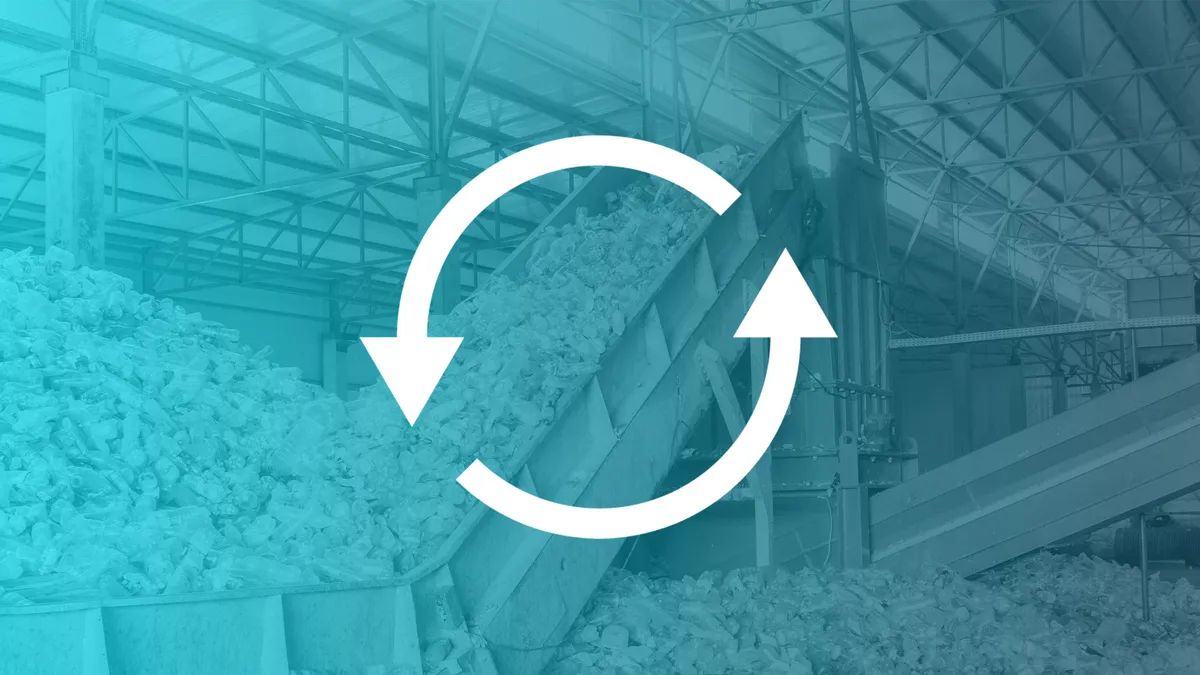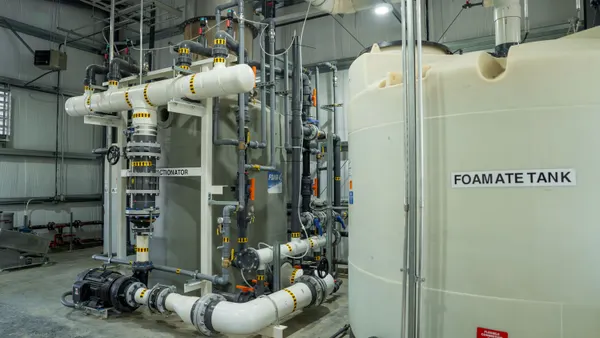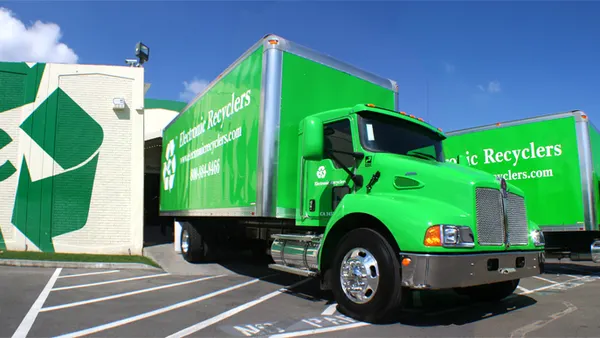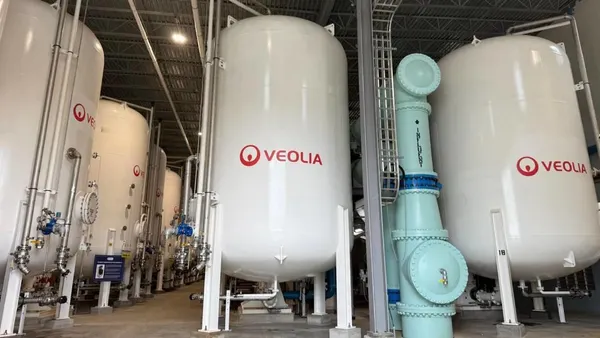Interest in the reuse and refill sector has continued to grow over the past year as more brands pledge to convert their packaging and startups expand to offer single-use alternatives.
Earlier this fall, the nonprofit Upstream and Closed Loop Partners once again hosted The Reusies award event to highlight companies such as Algramo, The Rounds, Thrilling, r.Cup and more that have been gaining market share.
Shortly thereafter, a progress report from the Ellen MacArthur Foundation and the U.N. Environment Program said a 2025 target of “100% reusable, recyclable, or compostable plastic packaging will almost certainly be missed” by most companies. The report lauded some new efforts, but found that signatories’ average percentage of reusable packaging was just 1.2% and “reuse ambition remains limited.”
Prior to that report’s release, Waste Dive caught up with Upstream CEO Matt Prindiville — who works closely with corporate sustainability officers, policymakers and zero waste activists — to get his take on how the sector has evolved since an interview last year.
The following interview has been edited for clarity and brevity
WASTE DIVE: What do the entries and outcomes of this year’s Reusies tell us about how the reuse economy is evolving?
PRINDIVILLE: We felt we had a lot of engagement the first year around when we had 1,200 submissions for different reuse efforts and companies and initiatives around the country. This year, we had over 4,000. It’s really exciting to see the kind of engagement that we are getting from people in the space, and I think it felt bigger this year.
I think it's mostly been viewed as kind of separate initiatives by different big companies or small companies doing things, or a city doing it over here or a business doing it over there. This is the first year where it's really felt like, wow, this is an emerging and growing sector, where people are excited and enthusiastic to figure out, ‘how do we take a lot of these great ideas that we're seeing in small scale, and how do we scale them up to make them the new normal?’
Which segments of the reuse and refill sector do you think had the most momentum this year?
Three-and-a-half years ago, when we did our first strategic plan in this area, we were focused on food service because most of the corporations had not yet come out with positions supporting reuse. Most of them were still opposed to the important policies that we need to get reuse going, like extended producer responsibility and deposit return systems or bottle bills. So we felt that the big opportunities were with cities, and with smaller reuse service providers working in the food service sector, to have reuse for on-site dining scale.
I think we saw a real shift [in recent years] where we were starting to see this change in position from many of the major brands and retailers around extended producer responsibility. We were starting to see this change in position from some of the big beverage companies around deposit return systems and bottle bills. And more importantly, we saw during the pandemic that a number of the biggest players in each of these sectors had all piloted reuse systems.
The fact that Coke came out and said that they were going to go 25% reuse-refill by 2030, that's a big deal. I mean they're already at 16% or 17% — we'd like to see that have a more ambitious target — but the fact that they put out a rates and dates type of target, that's exactly what we want to see all the big brands doing. And we want to see their support for operationalizing that idea through supporting reuse provisions and EPR bills and deposit return system legislation.
A lot of them have these ambitious climate goals and these ESG goals, but they know that just switching from plastic to paper or adding in a little more recycling is not going to have them hit their goals. I have several sustainability officers from major brands that have literally said to me, “I can't hit my ESG goals, my climate goals without reuse.”
You work a lot with these big brands, as well as with grassroots networks that may not like the idea of large corporations having control over EPR systems. How do you bridge those two discussions?
It’s not easy. For years, the advocates have been saying — and I've been doing this for 20 years — that we need EPR for packaging.
Here we are. So we're at this moment where we've been clamoring for brands to support EPR for packaging, and they are now and so that's a major success. But of course, the devil's in the details, and that's where things start to break down.
So you have folks that are more on the visionary spectrum that would really like to keep control of how these systems operate. They want to get to these big packaging sustainability metrics and building out these reuse systems and reducing packaging by huge numbers, and then for everything else increasing and getting up to these very, very high recycling rates. Then on the other side of the spectrum, you have folks more on the industry side that really want to be able to control everything and not have to listen to stakeholder feedback from anybody else besides the consortium of brands.
At Upstream, we think there's a happy medium. I think that ultimately the role of civil society and the role of government in EPR legislation is really to set the goal posts and to create the rules of the system. And then let the private sector innovate to meet those goals and to achieve the intent of the legislation. That's why it's so important to get reuse and packaging reduction front and center as goals, to have teeth in the legislation.
Their biggest concern, I think, on the brand side is that they're going to have legislation where everything is super prescribed, and all that they do is write a check to city government officials to collect their packaging for recycling. I know that brands would like everything to be harmonized right off the get go, but from our perspective, it's okay to be in an experimentation phase.
The most important thing is that we're driving progress forward so that we're not slipping back into really outdated ideas for what EPR should be. We want the brands and all the stakeholders to see EPR as a tool to fund the creation of a circular economy for packaging that prioritizes packaging, reduction, and reuse systems ahead of recycling, but also recognize that we're not going to have reuse for everything.
If this scales to the level that you want to see, is it going to need a national harmonized system or is it inherently more regional in nature?
I think that what we are talking about is a regionalization of supply chains. The hope is that we're going to move away from these big, massive supply chains for single-use materials and packaging, as well as these big massive supply chains for recycling.
We've now got these huge supply chains that stretch across the globe for material creation, packaging creation, as well as filling product and shipping. So the idea is that if we can make all of that effort going into making that package once, and then cycling it as many times as possible in these reusable supply chains — really shifting from the idea of packaging as a product to packaging as a service — now we're really starting to get somewhere. And that's going to be regional, no question.
When people ask me what are the biggest barriers and how do we overcome them, the biggest barrier is infrastructure. We haven't built that infrastructure. We used to have it. In some other parts of the world we have it for soda and beer and other types of products, but we have to build it anew here in the U.S.
That is really going to start with cities, with efforts like Reuse Seattle where you have different stakeholders, government, NGOs, businesses coming together saying, “okay, we want to build this thing. What are the foundational building blocks?’”
We don't necessarily think that consumers need a new reuse bin like they've been trained to use the recycling bin. If we can change the MRF to accept the reusables, isn't that a hell of a lot easier for the consumer than adding a reuse bin? However, there also might be some needs for reuse bins and there are also some ways to also take advantage of the fact that the logistics companies, the UPS' of the world and the Amazon deliveries are coming to our homes, apartments and offices several times a week.
What is your latest thinking on the role of waste haulers and recyclers in this model? What are you hearing from them?
Depending upon who you talk to there's either excitement, or fear, or a mix of both. And I think that's entirely appropriate, because what we are talking about is really shifting how we consume.
We used to do reuse, refill. There's all these examples not just from the past, but that still exist today around the world at scale. But we're able to do that now with AI, modern logistics, QR and barcoding and RFID. There's so many modern inventions that we can now put at our disposal to really optimize these systems and to have different people that are in the value chain make money through optimizing those systems.
So this is a golden opportunity, I would say, for the waste management and recycling sectors to really look at their business models and look at what the business models of the future are gonna look like for these companies and say, "maybe I don't want to just let this upstart reuse service company get all the business. We actually have capital, we know how to run trucks and logistics, we have all the permits to get in and out of the industrial parks of cities.”
With food service, could you change the MRF or could you change the collection to accommodate things like polypropylene reusable to-go containers, or polypropylene to-go cups, or stainless steel to-go cups? With the beverage industry, it's going to be a lot of refillable glass and refillable PET. In the CPG sector, you can just look at what is Loop serving their products in — it’s a reusable, aluminum and some steel, and it's reusable polypropylene.
I guess we’ll know it’s getting big if ones of those local companies gets bought by a big waste and recycling company.
That's right. And one of the things that the recycling companies and the waste management companies do have is those models are typically more regional than your average CPG supply chain. So we think that's an opportunity to really capitalize on that because the new reuse economy needs that. And then over time we're going to see more of that effort around packaging move away from recycling and get more focused on reuse.
Is it going to be a regulated utility model where somebody wins a contract from a city? Or is it going to be a competitive marketplace where lots of companies are coming together and competing for business, but it's the same collection infrastructure for the consumer?
That's a big part of what we hope comes across through these new EPR bills getting passed is that the designers and the implementers are really thinking about how do we prioritize reuse, how do we build it and what kinds of provisions are going to be the ones that enable us to fund this and not just fund some improvements at the MRF?
The goal is not cost shifting, the goal is not more recycling. The goal is a circular economy for packaging, and that follows the waste reduction hierarchy. It's that simple.












